Wales, UK
VK4ION
Visiting Wales
In search of Turners
Travelling with a small bag and a backpack... let's get this party
started.
A note about my luggage; I travel with an 'International Carry On'
wheeled bag made by Tumi, which I check in. It's the perfect size
that I can handle with ease over any terrian.
It can be difficult to find this size bag as it isn't part of the
common 3-case-sets.
I love
Tumi, the brand, and
purchased my wheeled bag in 1994. Expensive? yes, but it's been well
used in the 20 years without a problem.
It's March 2016.
That's early Spring in the UK.
I'm in search of Turners... the paintings of JMW Turner and I'm
looking for the ancient trails of pre-Roman Wales & the Castles of
the Welsh Kings who kept the Normans at Bay.



West to Wales
On GWR Cardiff train
Being a Sunday the rail network was under repair, so we were diverted to some minor rail lines, following farmland and canals. I saw my first canal boats and fishermen sitting along the banks.
The red dragon leads the way
Cardiff - Capital of Wales


It took 4 hours from London to Cardiff, due to the rail diversions but was well worth the time. Cardiff railway station is a monument to the Great Western Rail company and it's in the centre of the city. It was easy walking to hotels or buses.


It was an easy walk from the station, past the Millennium
Stadium, over the Bridge on the River Taff to my B&B - Austins
Guest House, with the cutest little single room.
Jet lag 4am - HUNGRY... So up early next day to wander about
Cardiff City.
Cardiff
Following the River Taff and the daffodils
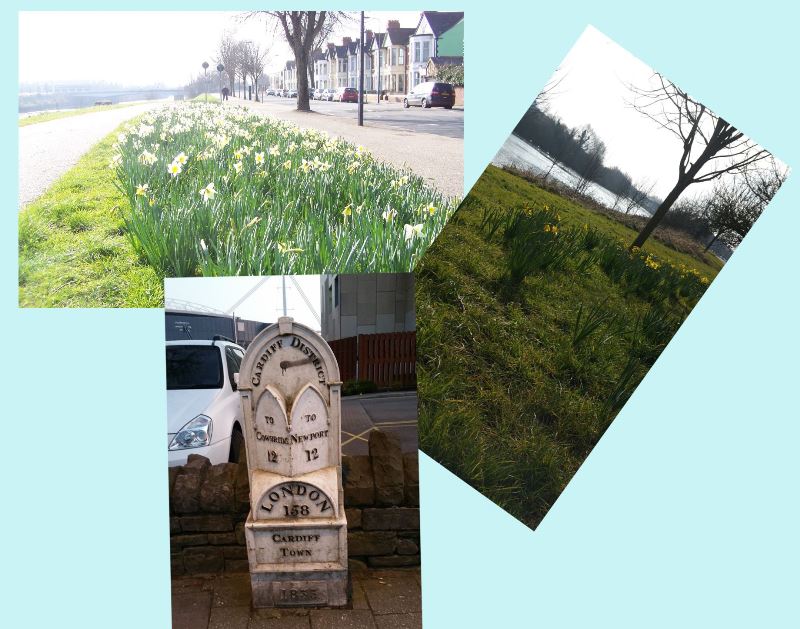
Following the River Taff, and the Daffodils begin to appear
everywhere... little did I know they'd follow me on my entire
journey.
The city is a wonderful mix of old and new. Tucked between new
brick and glass you find carved arched walkways.... very few
straight lines in the old parts of town so navigating takes
time. I'm on a mission, heading for the waterfront.

Doctor WHO Alert
This is the Rift


The Millennium Centre with the famous carved message in Welsh
and English - These Stones Horizons Sing.
The gleaming silver tower and the sunken courtyard - officially
it's the Roald Dahl centre (he being Cardiff's famous son) but
to me, it'll always be the place where the TARDIS comes to
recharge by sitting on the Rift - a split in the fabric of time
and space!
Things you see... Like this Antique carousel and weird statue in a park... Dahl inspired maybe?? It wriggled its way around the park.
Doctor Who Experience
It's not just an old blue box
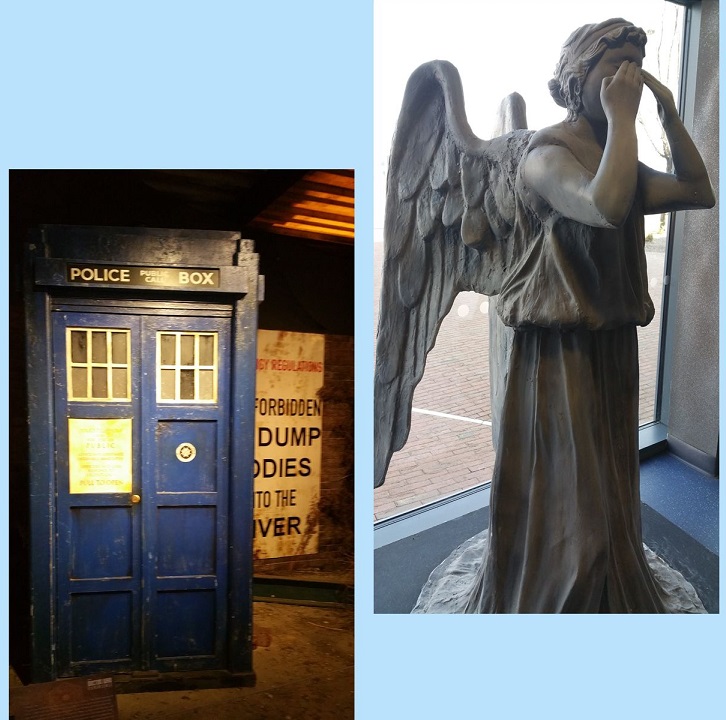
We all know the TARDIS and how important it is NOT TO BLINK! and
that there's no word for water or translation of Melody Pond...
other than River Song! (you either know what I mean or you think
I've lost the plot)
So glad I visited this exhibit as it isn't in Cardiff any
longer. The lease ran out so they closed it down.


This is Cardiff Castle - and the tourists flock here. It's an
eclectic architectural mess, built and rebuilt... some parts
look ancient, others like a Disneyland towers.
It was the strange castle wall which caught my eye. These animal
sculptures are a later addition to the wall because old photos
show just smooth stone.
They are quite wonderful and appear to be making their escape
over the wall.
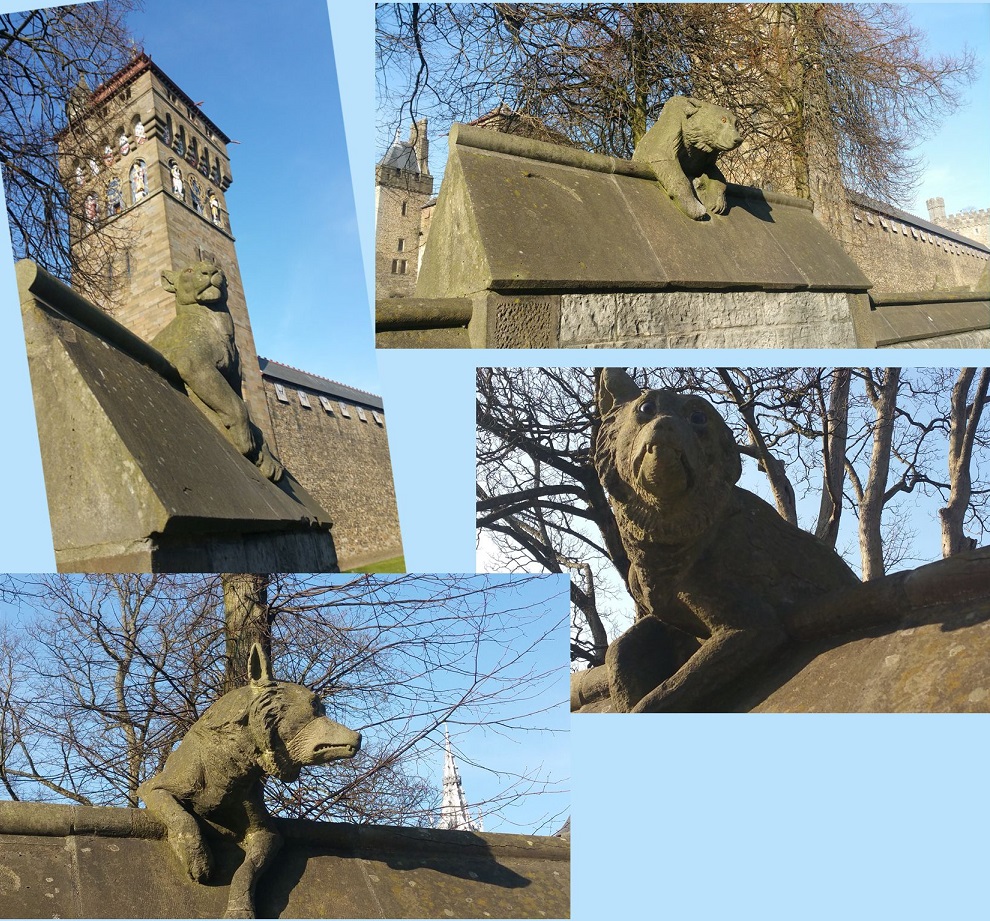

Lot's of old churches, magnificent gardens... and DRAGONS
everywhere... The Red Welsh Dragon being the symbol of Wales.
Finding pubs and friendly locals to sit and chat with isn't
difficult and warm pubs with nice beer sounds like a plan.
The National Museum
Art Gallery and the original home of the Turners

A magnificent building with impressive columns and tall metal
doors.
I feel I know the interior of this building...
It's been used in Doctor Who episodes, such a brilliant showcase
of Cardiff and Wales.
The locals I spoke with said the traffic was bad on days when
production shut down streets but for the excitement of
international filming and all the kudos it brings to Wales; they
love Doctor Who.
The gallery has some wonderful art; amongst the classics is the
Monet and the Renoir of the Girl in Blue - which is gigantic -
it stands over 2 metres tall.
There were the Turners!
These caused trouble in the artworld, being thought to be fakes
and not exhibited. Once authenticated as being Turners, they're
on display.
So I've seen them and wasn't disappointed.
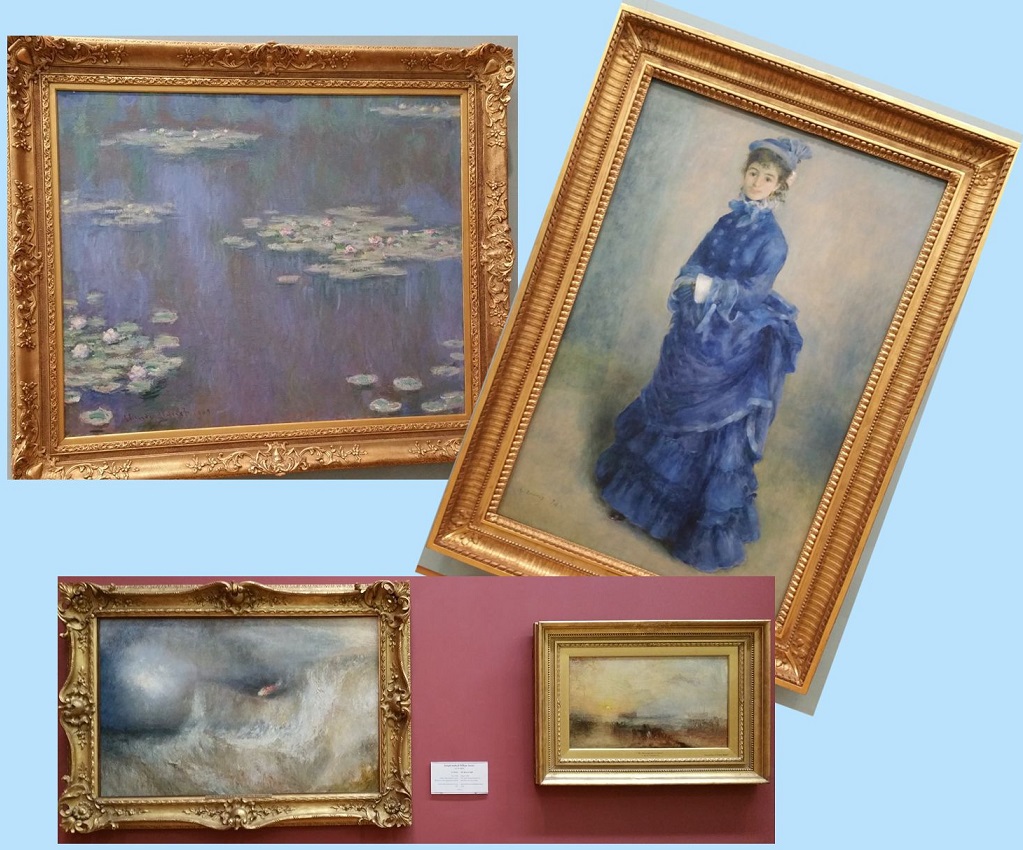
It was time to move on
Headed off and only reached Penarth!
I had a map and picked a spot and jumped on a bus. The driver
said I was there, after about 10 miles! Oops, it looked further
on the map. But I was on the move now so checked into the Cefn
Mably Hotel, with great food & cheap beer.
I decided to take photos from my bedroom windows on the trip...
this one is quite pleasant, narrow back gardens of people's
houses, very neat and tidy.


I picked up a rental car, a cute little 1000cc Toyota and they
did require my International Driver Licence as well as my
Australian Licence.
I'd planned to drive around Wales in a clockwise direction
following the ins and outs of the coastline. The entire country
is only 400km long.
First stop Barry.
And I begin to take photos of what I thought were castles and
old buildings... What a dope, I had no idea what lay ahead.

This was Llantwit Major on the Bristol Chanel.
The villages were cute and the narrow roads were interesting and
take some navigating with oncoming traffic - I appreciate my
tiny car!
The rolling hills with wind turbines were everywhere in the
south... There was a hazy mist most mornings and it gave the
land mystical appeal.

Wales is on a par with New Zealand for post card picture material and when you think it couldn't get more picture perfect, another ocean village comes into view.
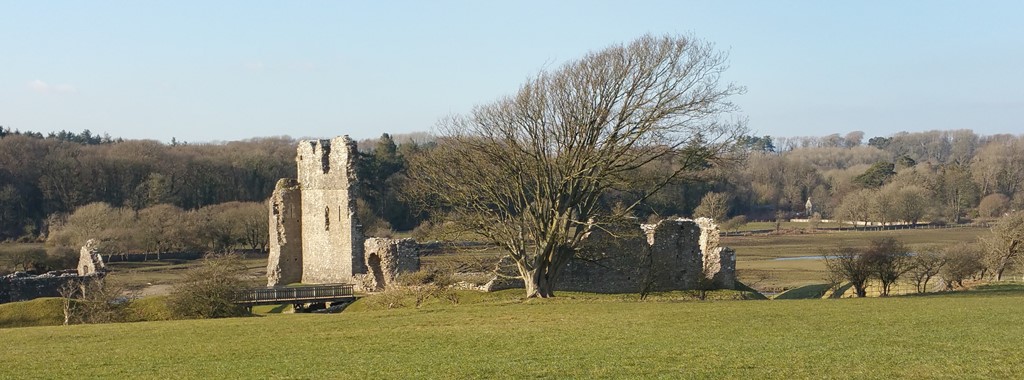
My first ruins... I was so excited I had to post it on Facebook.
It was at Bridgend and I had my first Bara Brith at a little
community tea-house.
Stopped at the Angel Inn at Mawdlam, where I was made to feel
very welcome. The food was outstanding along with some
empowering graffiti on the walls.


I'm not a Christian or religious but the churches and
churchyards will figure heavily on my journey.
Apart from Castles it's the churchyards which tell much of the
story of Wales. Many of the churches aren't mentioned in the
history guides as they're only 400 years old and not 'old
enough' to be considered historical. Being an Aussie I find that
funny as our oldest building are less than 250-years-old, and we
think 19th century is OLD!
Carew Castle & Mill
A little game-of-thrones going on here
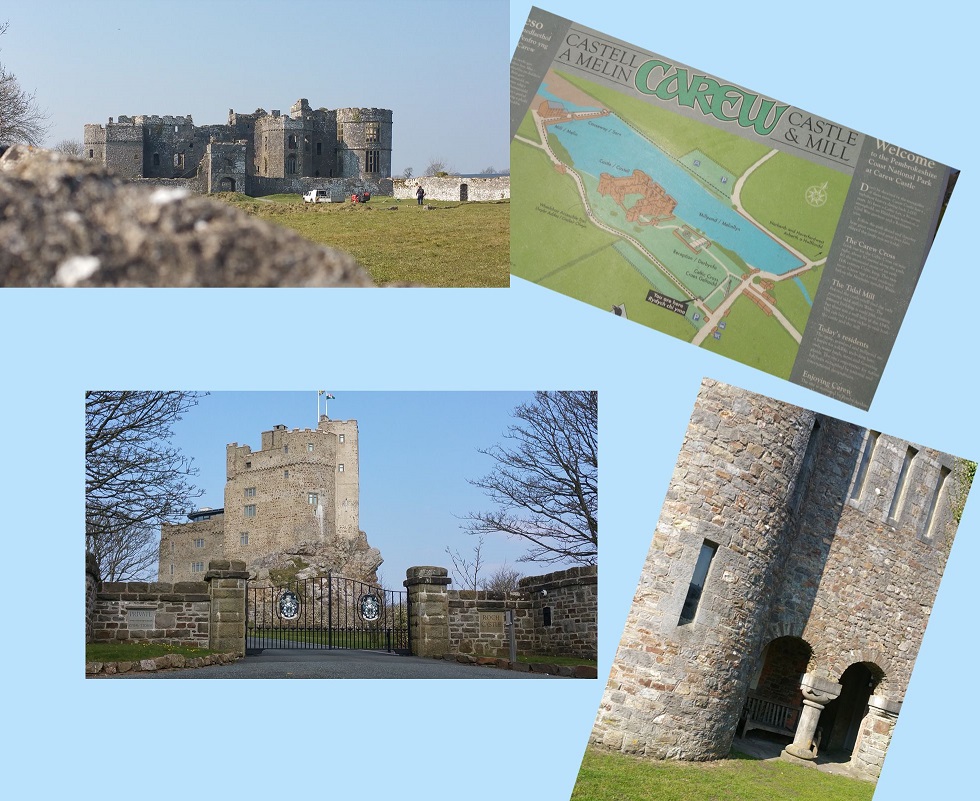
It all begins to look a little 'Game of Thrones', thick walls,
turrets, arches and slit windows.
The one in the lower left is a Private residence now - In ages
past somebody built a Castle Keep on a rocky outcrop and in
modern times they've added glassed-in areas to make it
comfortable.

Another magnificent coastal view awaits as you come over a hill.
I'm just wandering about following signs that pop up as I don't
really have a travel plan.
On my must-see list are places like Aberaeron and Aberdaron.
Pentre Ifan burial chamber - 3500BC
Better than Stonehenge with its roped-off area and tourist buses

I was alone in the wilderness, with only the sheep in the
paddocks.
To walk around and touch these stones and wonder who did the
same for the last five and a half thousand years - now that's
'the past'.
Driving along a lonely, narrow road a sign said; 'Ancient Celtic
Monument', so I park and wander a few hundred metres through
farmland to find this.
This has become my favourite memory of Wales.
I found it by accident but if you want to find the area it's in
Pembrokeshire - and this site is about half way between
Fishguard and Cardigan. The closest little town is Newport. So
yes, it's hard to find but so worth the effort.
Aberaeron

Arrived in Aberaeron and found a tiny B&B sign on a Steak house
wall. I rang their bell and the room turned out to be above the
steak house.
The strangest room I've ever been in. Entered via the public
toilet, which I could lock! Then came a tiny room with a shower
to pass through into an equally tiny bedroom with a giant bed.
Strange but somehow comforting.



My journey is a series of run-along-the-coast and then dart inland, so I can cross the river - to get back to the coast.


How many years did it take to pick up the stones in the fields
and make the fences? And they still build the walls in this
manner. Two Rows of horizontal stones, topped with vertical
stones - and repeat!
I mentioned how many river estuaries there were and sometimes
it's a long drive to go inland to find a bridge - someone had
this brilliant idea.

The landowners built a private bridge and a wooden deck just
above the water and charge 70-pence to cross.
I'm actually in the Snowdonia National Park now.
Not sure how the land/water can be private property, perhaps
it's an ancient charter or right to put a toll there. There are
gates they can close, so it is theirs and not a public access
road.

The cemetery is built right on the cliff and slopes quite
steeply, it's a wonder it hasn't slid over the edge... Daffodils
make their presence felt once again.
So now I'm used to the fact of coming around a corner into a
village and seeing a mighty castle or fortress towering high
above. You can imagine why they built on the heights, to keep an
eye on the sea and a lookout for invaders.


Once again a simple roadsign showed "ancient site" so I swerve
off the road to take some really rough country tracks to find
this Medieval hallhouse with a central cooking fire.
Such hidden treasures, things you would not see if travelling
via the motorways. I'm loving these country roads.
Aberdaron - my favourite village
Welcome to the end of the world

Something was drawing me here so I wound my way out onto the
peninsular and there was the most beautiful old village by the
water's edge. This 'double church' built so close to the ocean
was so beautiful.
I checked into my hotel (The Gwesty Ty Newydd) and the view from
my window was this old church. I could hear the waves crashing
onto the beach all night.
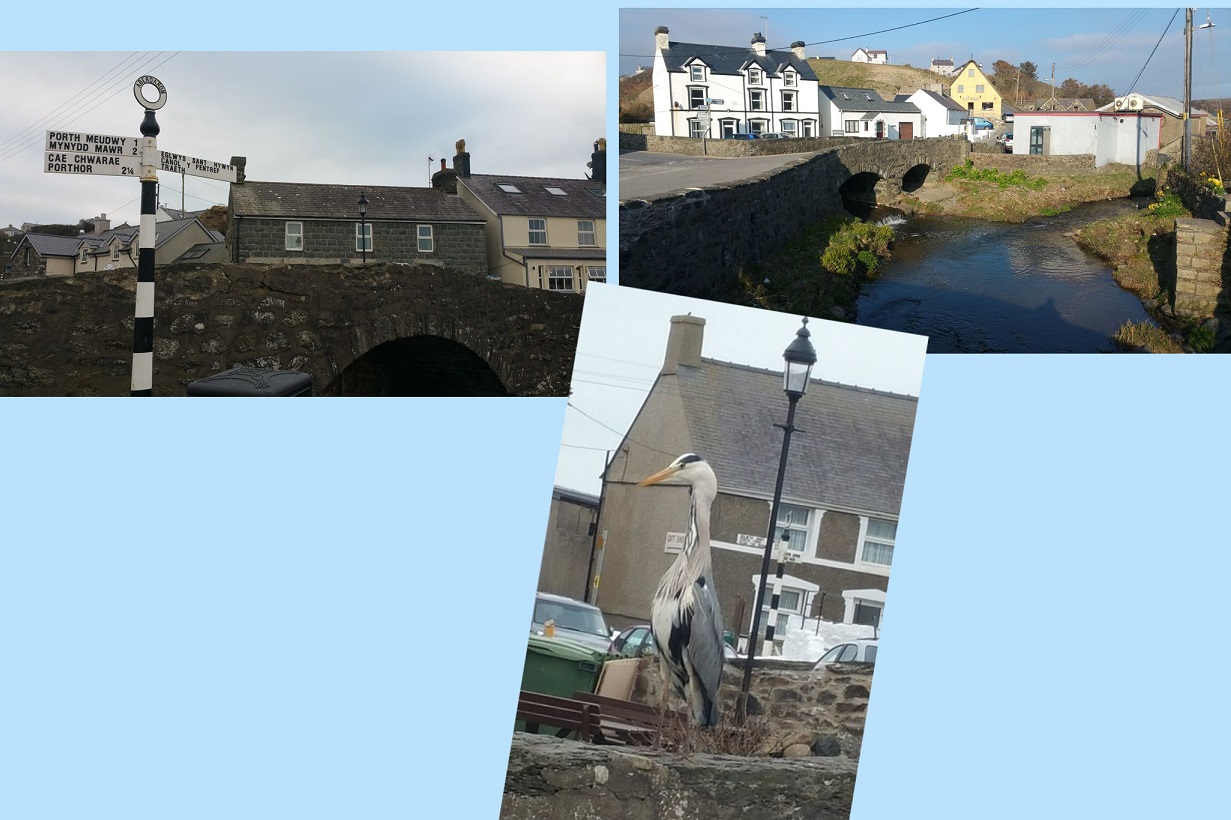
Everything about Aberdaron is romantic and historic... it was a
place for pilgrims as people came to Bardsey Island, called the
Island of 20,000 saints.
The origin of the place is lost but some say it's the "Isle of
the Bards," a sacred place of the ancient Celtic Druids of
pre-Roman Wales.
Another ancient legends says that Merlin the Magician is buried
there and some identify the island as Avalon where King Arthur
died.

On the road again...

Although the whole of Wales is dog friendly.... ARAF means SLOW
DOWN!
They've never heard of men with stop signs here, for roadworks
they stick up a traffic light and get on with it. Everyone is
polite and waits patiently, such lovely gentle people.
I'm in the really remote Welsh speaking part of the country. The
locals only speak Welsh to one another but will speak English if
they realise you're a visitor.
All signs are in Welsh first, then English which makes for scary
times when coming up to a big roundabout, and trying to find
your way... with words so long they hardly fit on a sign.
The Church of St. Beuno Clynnog Fawr
Founded in 630 by Beuno and until 1796 it was his tomb

Beuno founded a 'Clas' (a cross between a monastery and a
college - very common in Celtic church history) and it became a
famous centre.
The church as it stands now dates from around 1500 and different
church groups have added to the old original building.
St. Beuno's Chest - that's a hollowed out solid piece of wood.
There was a custom that calves & lambs with the mark of Beuno (a
natural slit in their ears) were brought by farmers to the
Church on Trinity Sunday, sold, and the money put in the chest.
Canarfon Castle
The famous castle which encloses a city

It's the site of the 1969 investiture of Prince Charles as Prince of Wales by his mother Queen Elizabeth II.
ANGELSEY - home of the Druids
Pre-Roman burial chamber

This is an amazing mound, with a circular ring of stones.
Once again, driving along and spot a small sign for 'Celtic
Monument' so I stop and hike through fields and sheep paddocks
until this opens up in front of me.
There is a front & rear entrance to the mound and the sun on
various stones told ancient people when to plant crops and
perform other annual functions. The tall rock at the front is
positioned absolutely North-South (this one is a replica - they
removed the original for safe keeping - it was so unique &
precious.)
What can you say about sitting where ancients walked and wonder
what they did and how they built this.
Take a close look at the big stones at the entrance, forming the
doorway. Now if you go back and look at the photo of Pentre Ifan
you see it's the same basic stone structure - a couple of big
upright stones with a huge lintel stone on top. That's how they
know Pentre Ifan once was a burial mound similar to this.
An old settlement - Caer Leb

It might not be much to see, just a couple of deep trenches with
encircling mounds of earth, but... the artifacts found here show
it was a big deal.
It was a structured community with defences and housing.
HOLYHEAD
Ferry port and gateway to Ireland

What an amazing place and hardly anybody knows about it's
treasures. Everyone seems to be rushing in to catch the Ferry
but it's an amazing place with great history and a lighthouse!
There is a rich pre-Roman history; then it became a Roman Fort;
then a Castle for the local Lord to keep an eye on those pesky
Irish.


A walk along the cliffs and down to this beautiful lighthouse. My phone switched to Ireland ! It thought I'd crossed over
Penmon Priory
The Isle of Anglesey
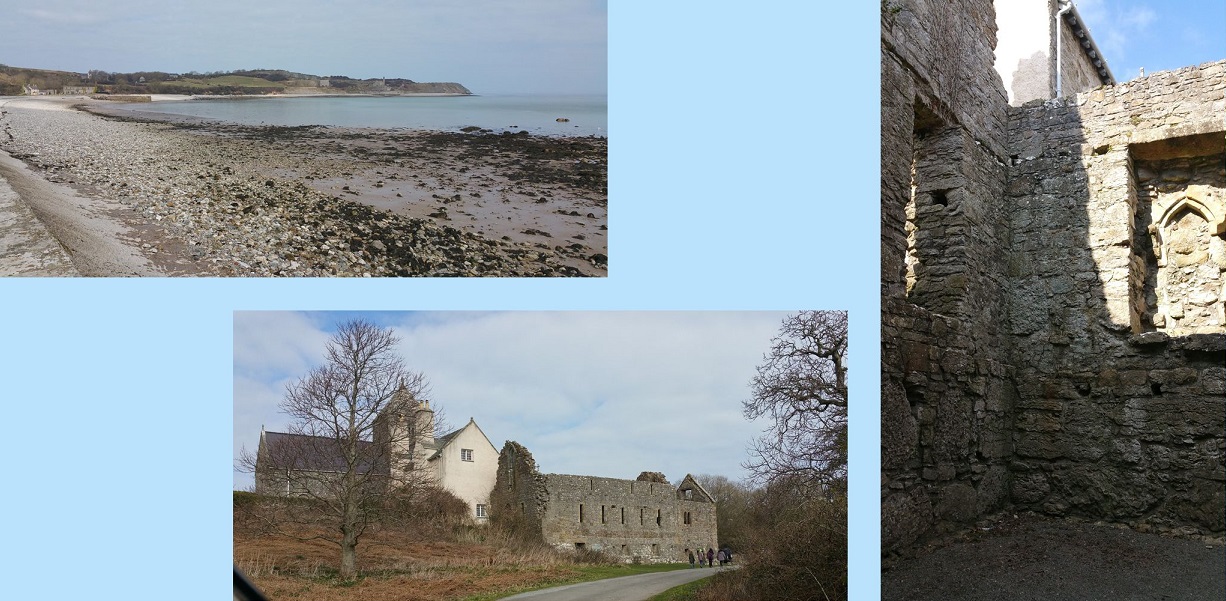
Penmon or Glannach, situated in the North East part of Anglesey was a Priory of Black Canons of the Order of St Augustin, dedicated to St Mary, founded by Gwynedd King of the Britains about A.D. 650.
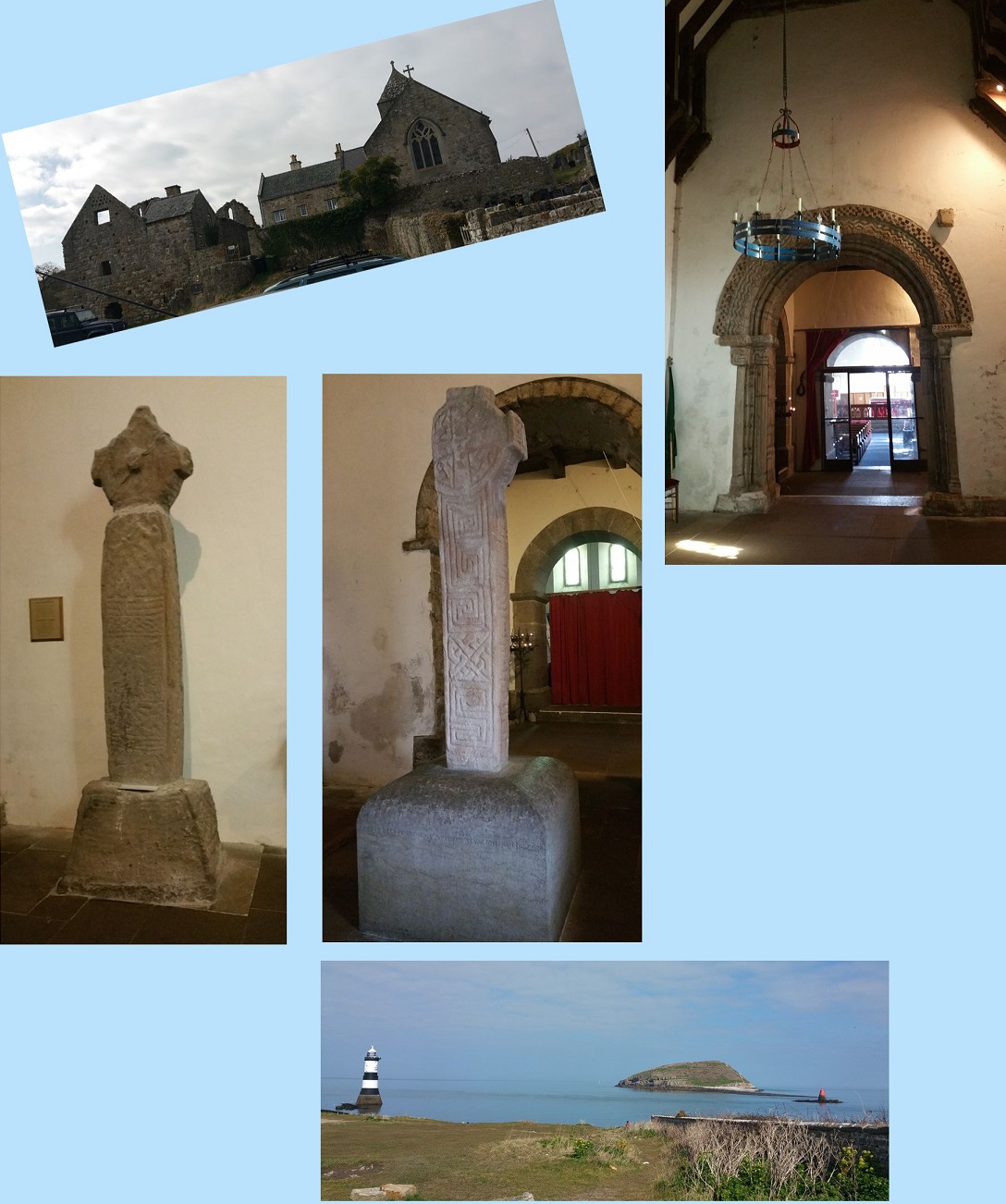
It is awe inspiring with stone fences surrounding an enormous
settlement which survives from the 6th Century.
The old Celtic crosses which had stood outside are now
protected, inside the building.
Conwy Castle
Ruins of Rhuddlan Castle

Moving along the north coast of Wales, I can see England across
the water at times.
Passing through some ancient cities, built as fortresses.
The City of Chester in England
Crossed into England and went to Chester
I wanted to see the old walled city and the Cathedral... my foray into the English territories


Chester Cathedral.

Following the River Dee
I found this place by mistake

I would never be able to repeat the journey but I found an
ancient bridge that I was able to walk and drive over.
It was something out of Ken Follett 'Pillars of the Earth'
books, which feature building a bridge into a market town - it
was the lifeblood of the village.
WOW was all I could say.

The Mott and Bailey Castle at Montgomery
The Key to Wales

I stand and look East into England, this place was perfect to
defend the Welsh border.
The original buildings were built by Roger de Montgomery, Earl
of Shrewsbury, around 1070, it was destroyed in 1215 but
subsequently rebuilt as this stone castle.
In 1267 Montgomery was the meeting place for treaty
negotiations, where King Henry III granted Llywelyn ap Gruffudd
the title of Prince of Wales. That didn't last long as they
double crossed him and that's why he's known as Llywelyn The
Last (the last King of Wales - before it's conquest by Edward I
of England).
After 1295 and the final Welsh War, the castle became more of a
military backwater and prison than a front-line fortress.
Montgomery was granted a Royal Charter by the king in 1227,
making it the oldest borough in Wales.
St Anno's Church Llananno
A virtually unknown saint
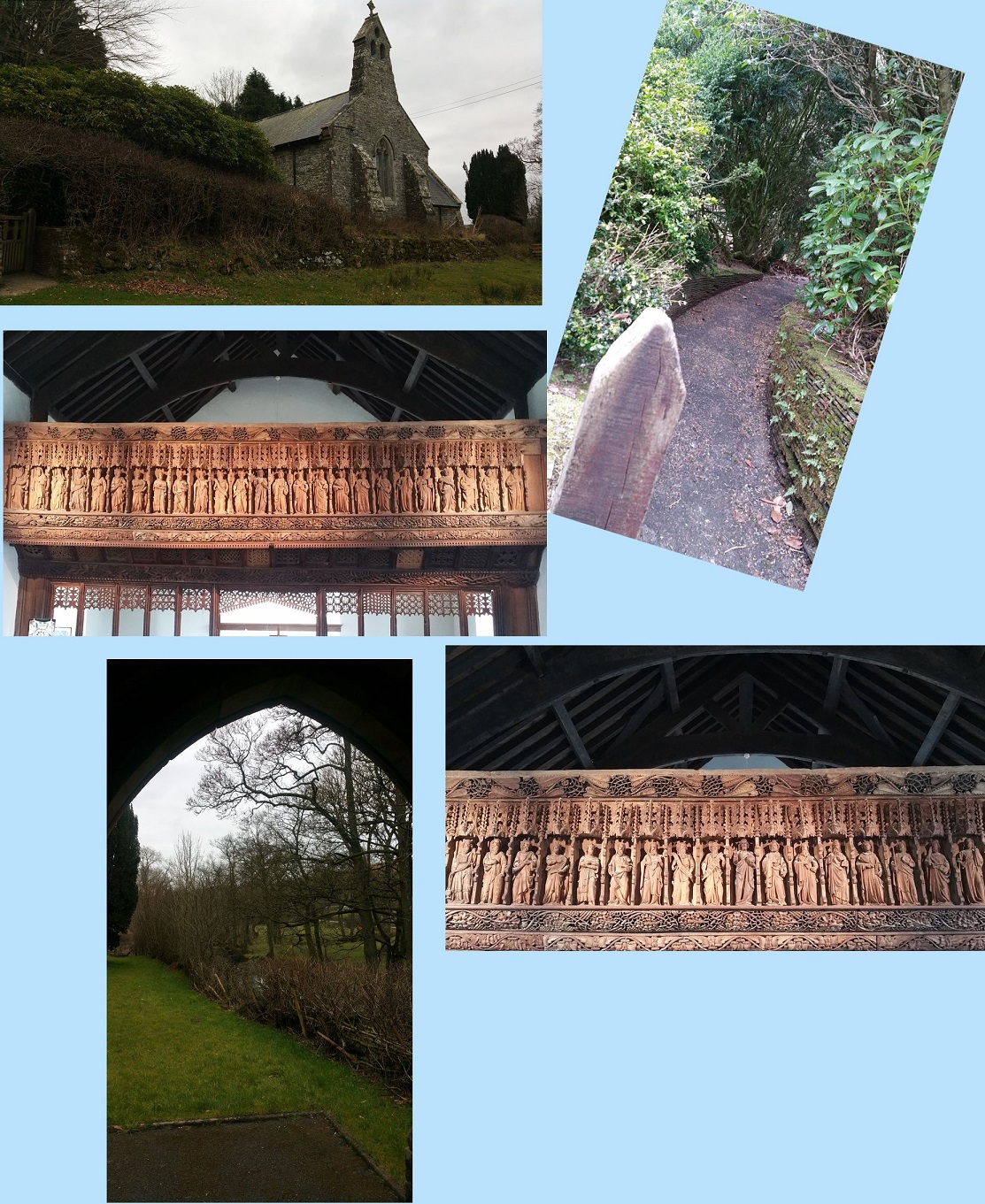
On a back road in a tiny valley a beautiful church dating from
the medieval period, dedicated to Anno, a virtually unknown
saint.
Much of the current structure has been restored but the superbly
carved late medieval rood screen is one of the finest in Wales
and is just breathtaking.
The tiny stream running beside this quaint church is the river
Ithon.
I felt totally at peace in this tiny pocket of tranquility.
Old Radnor Parish Church
13th Century walled town formerly called Radnorshire

When the Normans came to Old Radnor and found a church already
here, dedicated to a 6th Century Welsh saint St. Ystyffan, they
thought it meant St. Stephen and the name stuck.
The enormous font, standing on four squat feet is very much
pre-Norman and has been dated to 8th Century.
St Ystyffan was a member of the royal family which ruled Powys
c600-850.
This is another church which has had many re-builds but still
evokes the memories of medieval through to modern styles.
The Church of St. Meilig Llowes
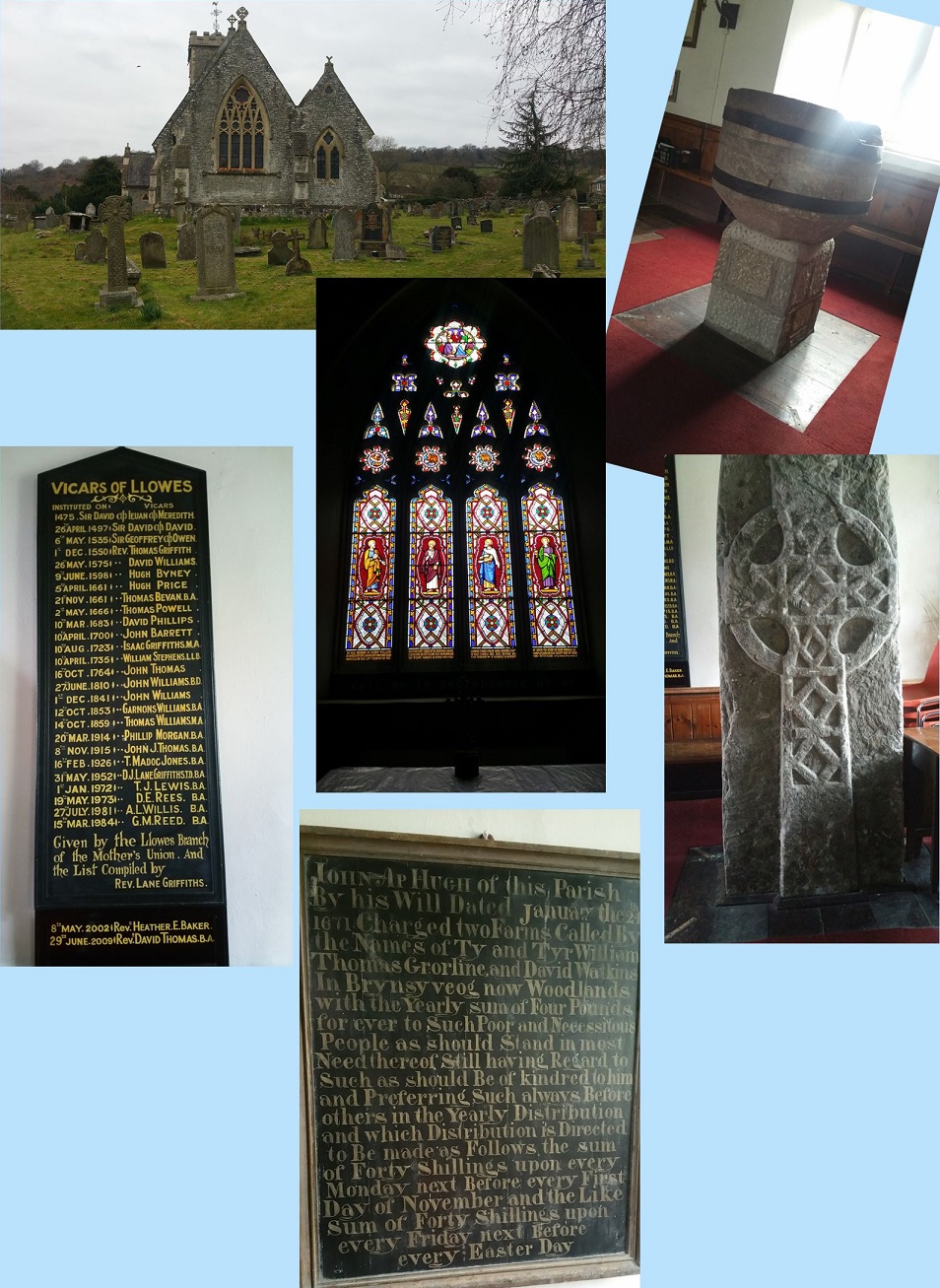
It was 6th C St. Meilig (son of Romano-British chieftain Caw
Prydain) educated by monks in Anglesey, who came to Llowes and
founded a monastery.
It's believed he's buried beneath the old stone building, which
has been built time and time again on the same spot.
While the stone has origins lost in time, the carving on the
slab is relatively modern - 12th Century!
Note the board tracing the Vicars of Llowes back to 1475, and
this large stone reads like the Last Will of John Hugh - makes
interesting reading and a reminder that he will always pay his
debts, because... it's written in stone in the Church.
St. David's Gate
The Bishop's house
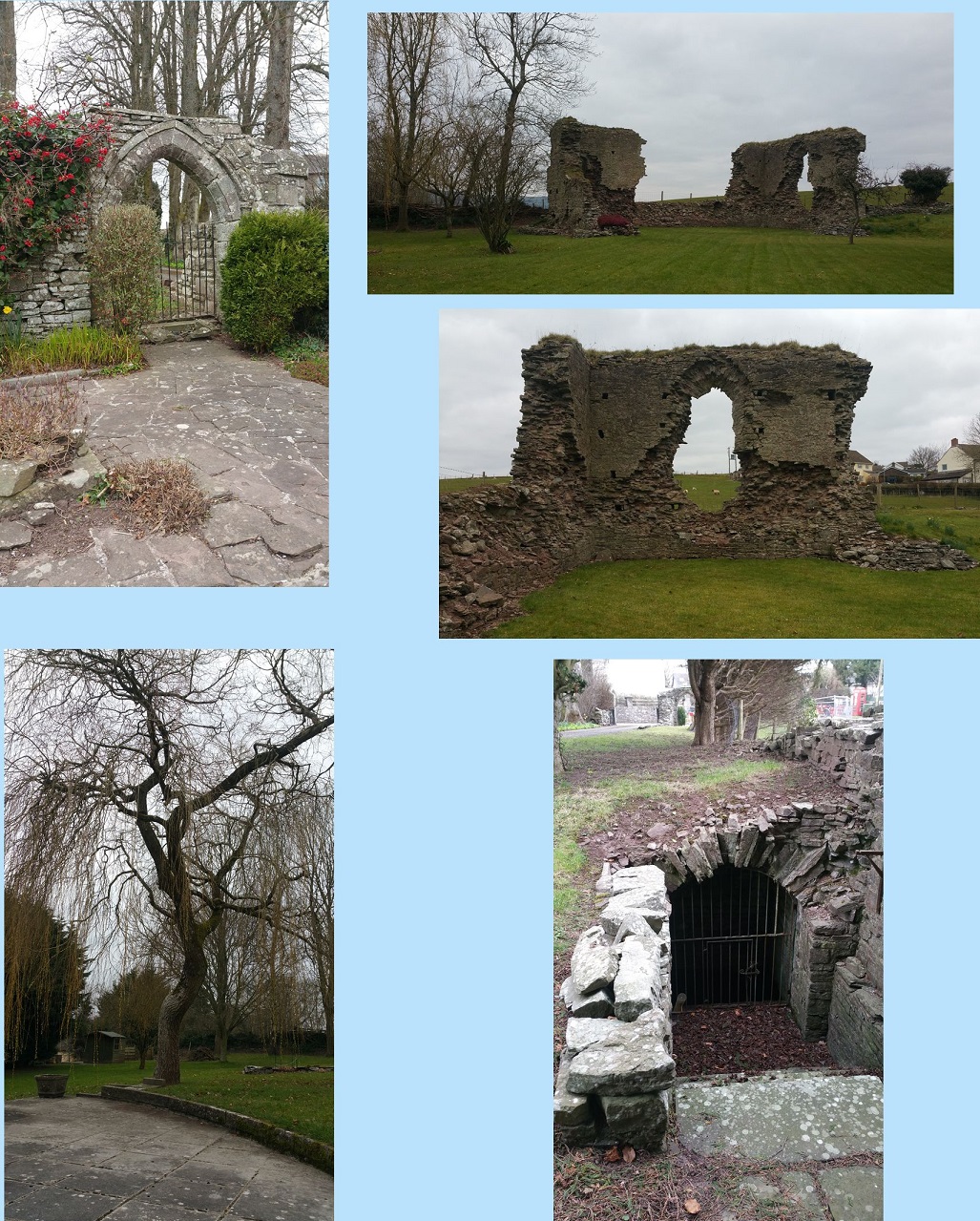
The well was half inside the Bishop's wall and half outside so the townspeople could also partake of clean water
It is just a gate but it was built in the 12th century and inside the grounds are ruins of the Bishops 6th Century residence. Bishops certainly lived well and it must have been a fine structure.
Llanddewi Brefi, St David's Church
Site of the Synod of Brefi from 550 AD

St David's is a large medieval church, founded in 1187 by the
Bishop of St David's, on the site of the Synod of Brefi.
Inside the church is a collection of 6th-9th century Celtic
stones.
The current building is 12th century but fragments of much older
carved stones are embedded in the walls. The church was restored
in the Victorian period.
The link with the past is emphasised by a collection of Celtic
crosses, some dating as back to the 6th century.
The 6 stones range from the 6th to the 9th century, and there is
a 14th century font bowl in the chancel.
Brecon Cathedral
From Agincourt to Doctor Who

The magnificent stained glass window, an ancient Celtic cross
with stuffed toys from the Children's play area - a
juxtaposition of ancient and modern.
The Cresset Stone held varying amounts of wax so each 'hole'
would burn longer - this gave light in the Cathedral when monks
had to come stumbling in during the long nights.
It seems that the history of this cathedral is tied closely to
the Battle of Agincourt 600 years ago. In the South Transept is
a stained glass window showing Sir Roger Vaughan of Bredwardine-
a knight in full armour - he was the local nobleman who fought
for Henry V and took local archers with him. Their names are
also commemorated on a plaque.
There is even the stone on which the archers sharpened their
arrows... so strange to find the story of Agincourt coming alive
in this cathedral.


Searching for 6th century Hermit's Well
I was determined to find one particular shrine

I drove for so long on dirt roads and in really rough terrain,
without mobile phone service and finally found the Hermits well.
It's named for St Issui of Patricio at Patrishow and the old
church further up the hill was built for the pilgrims.
For me the second most powerful site/memory of old Wales was
this old well. It's too old to know when it was first used but
there is record of Pilgrims coming in the early 6th Century and
if you can find it, come and leave "something" in the tree and
stones.
It felt like a Pagan place where people came, were moved, and
left something of themselves... so I left something too.
Up the hill, a Church - Patricio's
Open for all to enter

Renowned for the pictures on the whitewashed walls, the old font stone, timber rood screen and timber chest for the keeping of treasures.

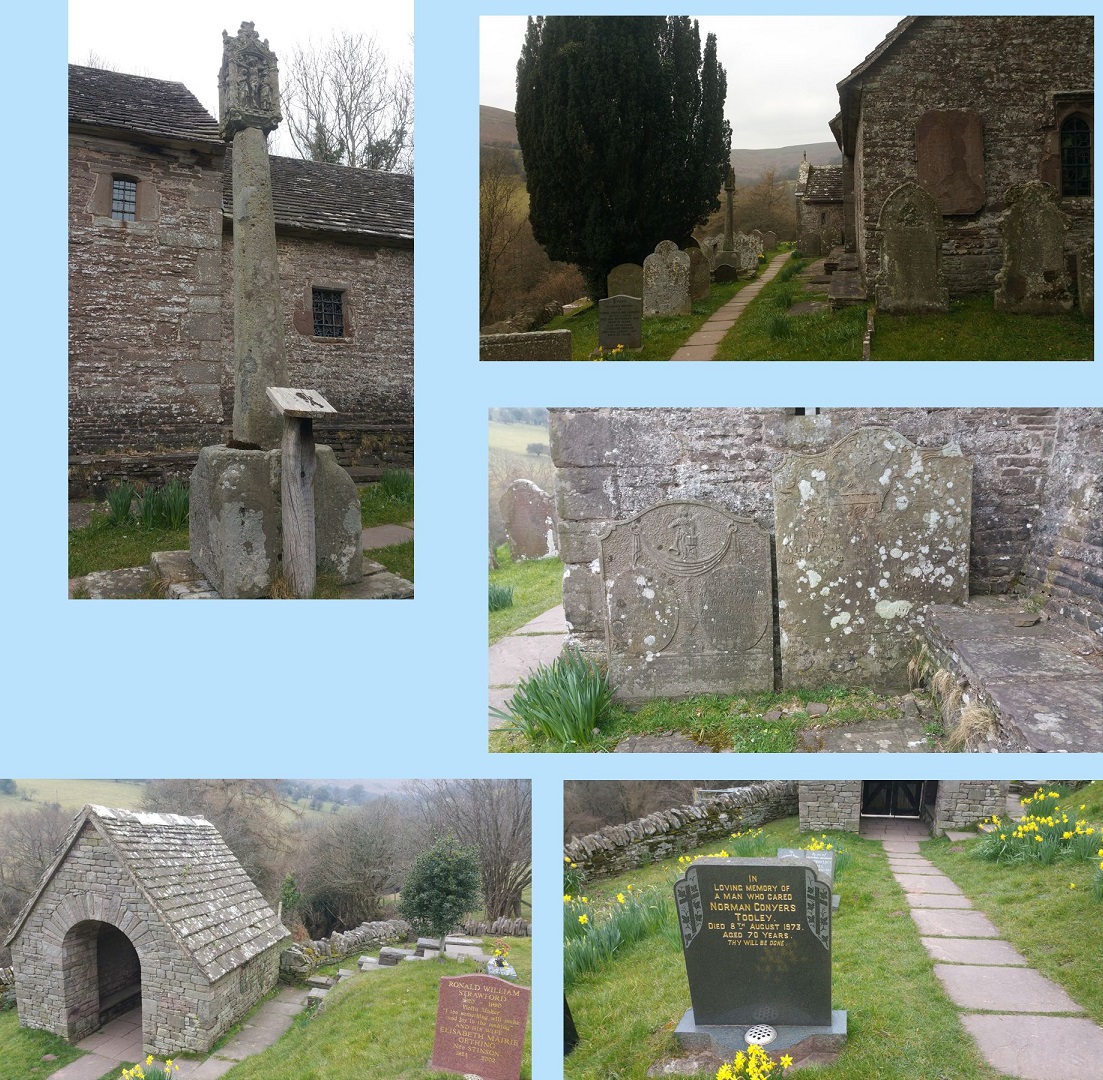
Then there was the graveyard with the Celtic monuments and stone memorial slabs leaning up against the building... and of course the daffodils.

Augustinian Priory at Llanthony
Beautifully preserved 12th century ruins
Llanthony; the priory begun by 2 hermits late 1000's...
amazingly huge and the architecture is astounding.
Absolutely gorgeous grounds and not another soul in sight.

Readers of Folletts books will understand the significance of your Cathedral falling away and demonstrates the detail of his research in writing his epic tales.
USK Castle
I'm in Monmouthshire
A strange blend of ancient ruins, private ownership and Meadow
Burials.
Yep, you can transported by horse and buggy and buried in a
whicker basket in a meadow, overlooking the misty Usk valley to
naturally return to the soil. Neat huh?


This was Coal Country
Statue - The Guardian

It is the largest mining memorial in Wales and commemorates the Six Bells mining disaster in 1960 which killed 45 men and boys in an underground explosion.


Caerphilly Castle
My last castle in Wales

Back to Cardiff to drop off my car - trying to recall the Beers I've tried: Gower Brewery - Swansea, South Wales. The Hopfather from the Wye Valley.
On to Bath Spa
Tourist town of modern 'fakes'

Everyone said you must visit the Baths to experience the roman
culture in Britain but is was an expensive tourist trap town and
such a disappointment.
Long queues to get into the Roman Baths which is to be expected
at a tourist exhibit.
It's an old site which has been built over, again and again. The
statues around the so-called Roman Baths are fairly modern and
actors dress as 'romans' to beg money from tourists. It is the
England of Jane Austin's time, and how they imagined the Romans
to have lived.


Down below there are a few lasting reminders of the ancient
world but most tourists don't go down underground to see... they
sit around the pool up top.
I decided that Bath wasn't for me so didn't bother to stay the
night after all. I wandered back to the railway station and
jumped on a London train.
Back to London

I found a great small hotel in Bayswater, just off Hyde park. An easy walk from Paddington Station with the smallest room I've ever had in all my travels around the world. 1.5m wide & 3m long.
The Tyburn Martyrs
The Congregation of the Adorers of the Sacred Heart of Jesus, of Montmartre, Order Of Saint Benedict
This is an order of nuns generally known as The Tyburn Nuns
because the site of the Mother House is the Tyburn Convent,
London.
The Foundress Mother Marie-Adele Garnier died and is enshrined
here and it's also the centre of pilgrimage in honour of the
TYBURN MARTYRS who shed their blood for Christ here between the
years 1535 and 1681.
What does all that mean? Well tucked neatly into the walls of a
street beside Hyde Park is this small chapel.

When Henry VIII was forcibly breaking up the Catholic religious
institutions and implementing a Church of England - some
resisted and died for their faith - this is a small monument to
the Martyrs - those who defied the King Henry and kept their
Roman Catholic Faith.
Their coats of arms and family names are displayed and venerated
by the order of nuns who maintain this chapel.
I found this a fascinating snippit of Tudor history, hidden
away.

The British Museum
The iconic building in London

Ancient Rome, Assyria & Babylon
Where to start... the cradle of civilisation. I went back to the ancient peoples and traced the story from there.

The famous relief carvings and tablet from the stairs at the Palace of Darius - the inscription written by King Artaxerxes III in around 350BC.
The first library to contain all knowledge



The Elgin marbles
Statues and freezes taken from the Parthenon in Athens

And before you decide what should be done with these
treasures... here's what the British Museum says...
"Built 2500 years ago as a temple to Athena it was also
converted into a church of the Virgin Mary in 6th Century, then
a mosque and finally became an archaeological ruin.
The building was altered many times and the sculptures damaged
over the course of the centuries.
In 1687 the city was under siege by Venetians and the Parthenon
was used as a gunpowder store.
A huge explosion blew the roof off and destroyed a large portion
of remaining sculptures, and the building became a ruin.
Archaeologists agreed that the surviving sculptures could never
be re-attached to the structure.
By 1800 only about half the sculptures remained and Lord Elgin,
British ambassador to Ottoman Empire - removed half the
remaining sculptures and transported them to Britain - with the
permission of the Ottoman authorities.
They are now housed in a permanent display and available to the
public for free.
The majority of the sculptures are roughly equally divided
between Athens and London. Important pieces are also held in
other museums, including the Vatican and the Louvre.
Those that were still in Athens continued to decay until they
were removed from the Parthenon to the Acropolis Museum in
1970s. The work to preserve them in Greece began 200 years after
Elgin."
You can read the facts and then decide!
More Treasures in the Museum.

I left the museum full of wonder and Wandered through the city, finally walking home through Hyde Park.

The National Gallery
Art, the love of my life

The art is just too stupendous to describe so I went on a journey from the medieval, through the renaissance until I found my Turners.
Some of my favourites

Francesco Pesellino 1445 Story of David & Goliath
Jan van Eyck 1434 Portrait of Giovanni Arnolfini & his wife
Leonardo da Vinci 1491 the Virgin of the rocks

Andrea Montegna 1505 the Introduction of the Cult of Cybele to Rome.
Bottom right is part of Bacchiaccia's 1515 'Joseph pardons his brothers' just to show the still vibrant colours of the oil paint, after all this itme.

Claude Monet 1899 Water Lily pond
Theo van Rysselberghe 1892 Coastal Scene.(in the pointilliststyle of Georges Seurat)
Pierre-Auguste Renoir 1876 At the Theatre (La Premiere Sortie)
Jean-Louis-Andre-Theodore Gericault A shipwreck
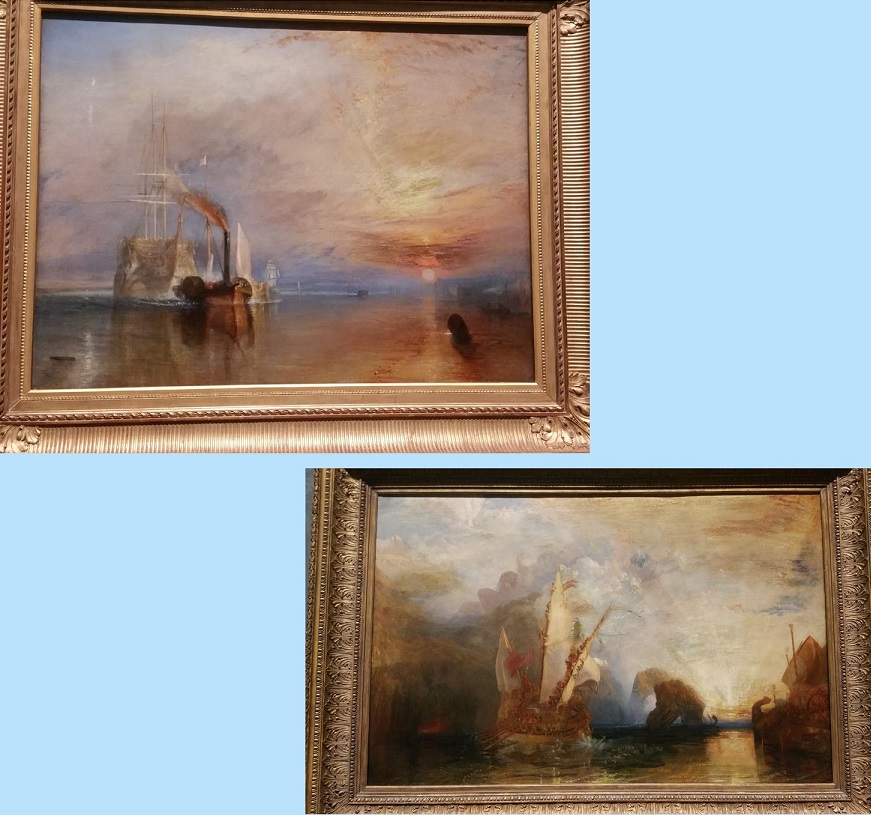
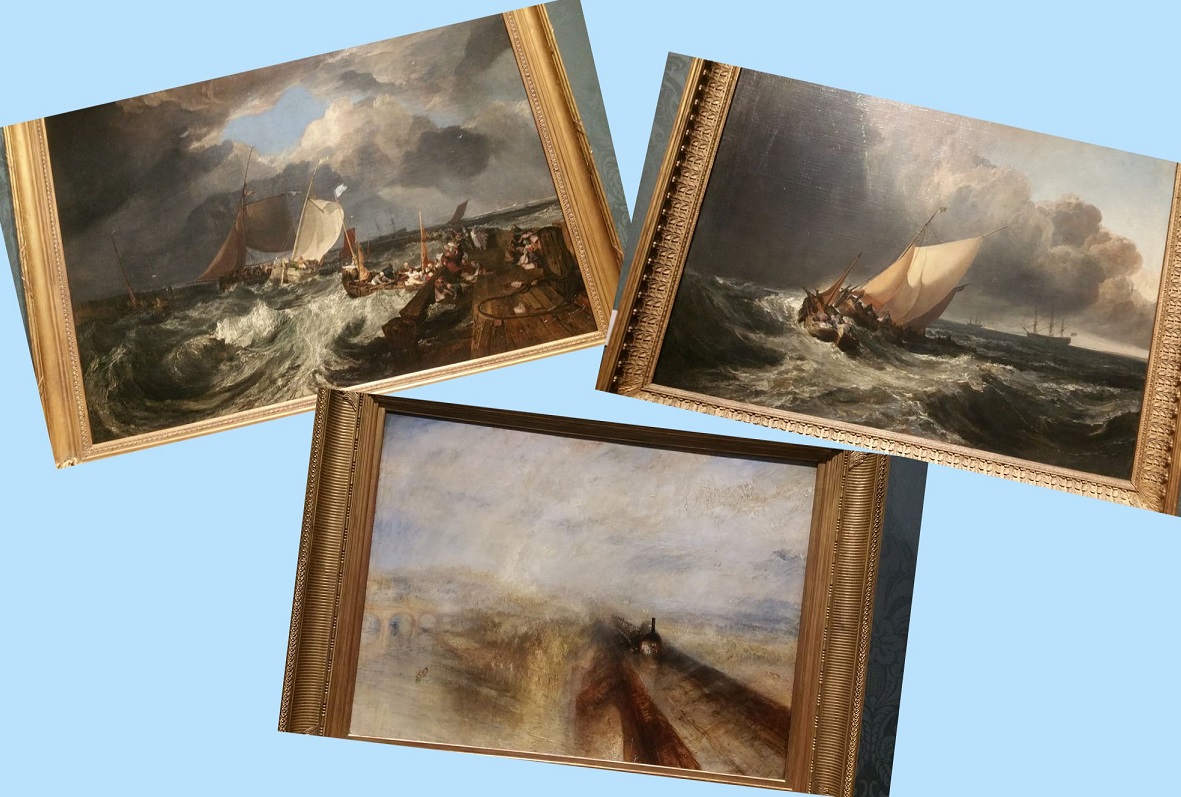
Dutch Boats in a Gale
Rain, Steam and Speed
Left the museum and headed for Paddington station... I had to
find a Paddington Bear (for Xavier)
Then Heathrow express train Heathrow to Qantas in Terminal 3 to
catch my flight - QF2 - London to Dubai.
Then Emirates Airlines flew the last leg Dubai - Brisbane and
home.
Best Memories

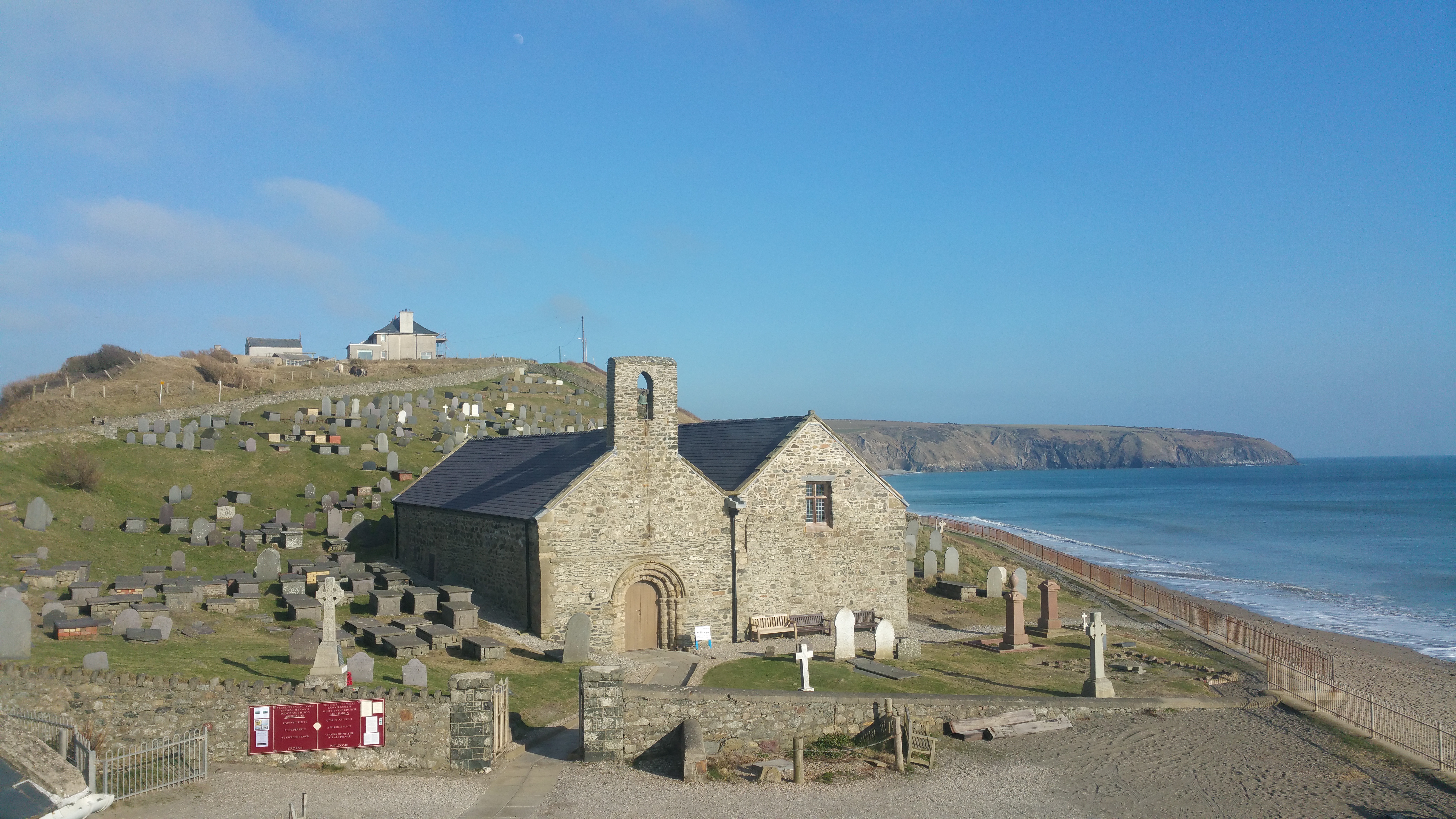
More Travels
Never stop travelling
Each of these links open webages where I share my some of my travels.
Contact Me
Please email me if I can assist with information about my projects (or if you notice a broken link).




